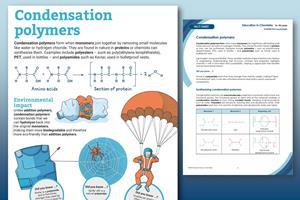Help your post-16 learners get to grips with how condensation polymers form and their applications

Condensation polymers form when many monomers join together by eliminating small molecules such as water or hydrogen chloride. They can be found in nature in proteins or they can be synthesised. Examples include polyesters – such as poly(ethylene terephthalate) (PET) used in bottles – and polyamides such as Kevlar used in bulletproof vests.
Lightweight, strong and flexible, these versatile materials shape industries from fashion to engineering. Understanding their structure, synthesis and properties highlights chemistry’s role in innovation and sustainability, helping us appreciate their benefits and environmental impact.
Download the resources
-

-

Condensation polymerisation: knowledge check and in context worksheets
Use these two different editable worksheets which provide a wide range of assessment questions exploring condensation polymerisation, including polyesters and the nylon rope trick experiment.
Synthesising condensation polymers
Condensation polymers are macromolecules made from monomers which have two functional groups. The functional groups at each end of the molecule undergo a condensation reaction to form strong covalent bonds, releasing small by-products such as water. Polyesters are formed by reacting diols and dicarboxylic acids, while polyamides result from the reaction of diamines and dicarboxylic acids.
The repeating unit is formed from one of each original monomer, while each end of the repeating unit joins with another repeating unit to create another ester or amide bond between the molecules. Two molecules of water are formed during the formation of one repeating unit.
Polyamide chains also occur in proteins, through a condensation reaction between the -COOH and -NH2 group present in amino acids. This links amino acids together into a peptide chain.
Want a refresher on addition polymerisation?
Get the poster, fact sheet and classroom activity to check learners’ understanding of how addition polymers are structured and named.
Physical properties
The physical properties of condensation polymers are shaped by strong intermolecular forces. Polyamides, such as nylon, form hydrogen bonds between chains due to the presence of -NH and -C=O groups. This gives them strength and flexibility.
Polyesters also exhibit permanent dipole–dipole interactions, contributing to their durability. These forces explain the versatility of condensation polymers in applications ranging from clothing to engineering materials.




Did you know…? Kevlar is a polyamide and is five times stronger than steel by weight, making it ideal for bulletproof vests. It can also withstand extreme heat and is used in spacecraft components
Did you know…? Toothbrush bristles are often made of nylon, a polyamide, and during the second world war, parachutes were of nylon too
Did you know…? Spider silk is a natural polyamide. Scientists have studied it to create synthetic materials mimicking its incredible strength and elasticity
Did you know…? Condensation polymers contain bonds that can be hydrolysed back into the original monomer molecules, making them more biodegradable and therefore more eco-friendly than addition polymers. Recycling is more feasible for polymers like poly(ethylene terephthalate) (PET), used to make bottles and textiles. However, overuse and improper disposal still contribute to environmental issues, emphasising the importance of sustainable practices in polymer production and use.
More posters with resources for your post-16 lessons
All illustrations © Dan Bright
Downloads
0325EiC - Infographic_WEB
PDF, Size 1.1 mbCondensation polymerisation fact sheet
Word, Size 0.48 mbCondensation polymerisation fact sheet
PDF, Size 0.14 mb












No comments yet